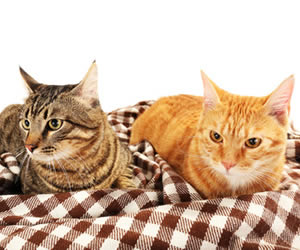Tips on Healthy Feline Skin

A feline’s skin and hair coat can tell a great deal about their general health and condition.
What makes up the skin and hair coat of a feline?Considered to be the largest organ, the skin gives form to a feline’s body. Together the skin and hair coat make up the outer covering of the body protecting the muscles, skeleton, and internal organs. The hair coat is found on the external surface of the skin.
What are the layers of skin?There are two layers of skin. The outermost layer is called the epidermis. This layer varies in thickness and can contain the pigment that gives a feline its distinctive color and markings and protects it from harmful sunrays. The innermost layer of skin is called the dermis. This layer is made up of connective tissue and contains the nerves, blood vessels, hair follicles, sweat and oil glands.
What are the basic functions of the skin?Because felines are such curious creatures they often find themselves in situations where they are at risk of injury or exposure to noxious chemicals or harmful environmental conditions. The cat’s skin provides a barrier that helps to keep bacteria, microorganisms, and foreign elements from entering the body, and protects the internal tissues from dehydration and loss of body heat by insulating against conditions of extreme heat and cold. The skin also acts as a receptor for the awareness of touch, temperature, pressure, and pain.
Feline sweat?Sweat glands are responsible for helping to regulate the loss of heat from the body through evaporation, and these glands are found in both humans and in felines. So, like people, felines do sweat; but, the sweat glands of a feline are only found on the skin of their foot pads. Overheated or excited cats will leave damp footprints as they walk away!
What are the functions of the hair coat?The hair coat also has specific useful functions. The outer coat is made up of primary hair, which grows from its own individual root. Connected to these roots are tiny muscles that enable a feline to fluff out its coat trapping warm air creating a form of insulation. Secondary hair, or the undercoat, is more abundant and also functions to provide added warmth and protection. Tactile hairs include the whiskers, eyebrows, chin hairs and the hairs found on the backs of the front legs. Tactile hairs are especially modified to provide detailed information about anything that they touch which gives important sensory information to the cat. Whiskers are longer, thicker, and stiffer than normal hairs and a feline can fan them out, and rotate them forwards or backwards. The nerve endings in whiskers are clustered and help to supply a feline with detailed information about air currents, air pressure, or objects close to their face. This information helps to supplement the feline’s other senses of smell, sight, and hearing and are useful when investigating objects near by.
What does a healthy cat’s skin and hair coat look like?Different breeds have different hair – short, medium, or long and fine, medium or coarse, but all healthy felines should have shiny and mat-free coats. A feline with dull fur that breaks easily or has bald spots may be indicate that there is a health issue and your veterinarian should be consulted.
Would you like to see more information regarding feline health like this in your inbox on a daily basis? Visit our website for more tips on cat skin and hair coats!
Do you see felines that require help with their skin and coat? Visit our products page to learn how to keep your feline skin and coat healthy!
Careers
Are you looking for a place to let your talents shine? At Covetrus, we help our practitioner customers better serve their patients and take pride in providing the best customer experience possible. Search our open positions to see our available opportunities.
Newsletter
Stay current with what’s going on with Covetrus, subscribe to receive our newsletter and email communications. Subscribers will receive the latest information in practice management, sales and marketing, animal health, and more.


Leave a comment